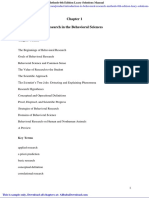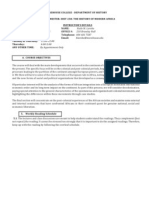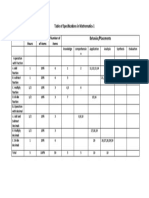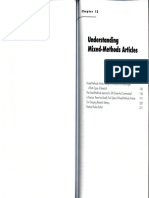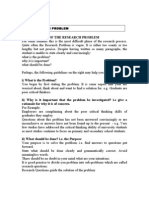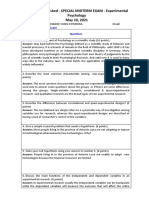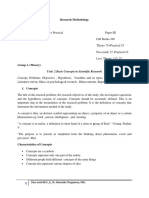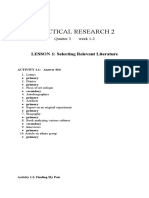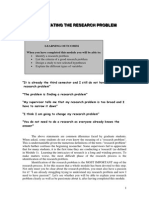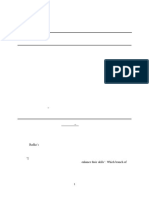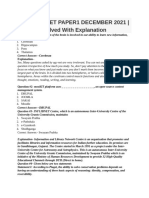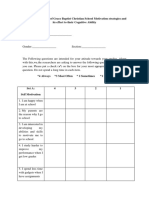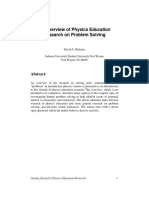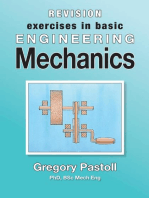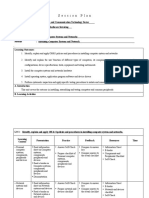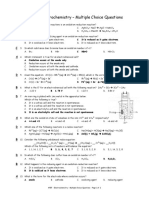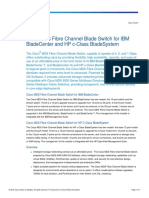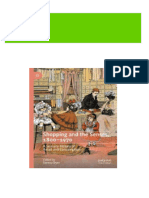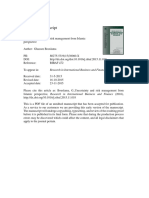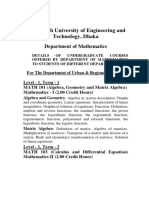0 ratings0% found this document useful (0 votes)
65 viewsKinds of Questions
Kinds of Questions
Uploaded by
June CostalesThe document discusses Bloom's taxonomy of educational objectives which classifies different levels of understanding that students can achieve. It outlines the six levels from lowest to highest: knowledge, comprehension, application, analysis, synthesis, and evaluation. The author expects students in an introductory psychology course to achieve the lowest three levels, which are best assessed by multiple choice questions. Examples of multiple choice questions targeting knowledge, comprehension and application are provided to illustrate question styles.
Copyright:
© All Rights Reserved
Available Formats
Download as DOCX, PDF, TXT or read online from Scribd
Kinds of Questions
Kinds of Questions
Uploaded by
June Costales0 ratings0% found this document useful (0 votes)
65 views6 pagesThe document discusses Bloom's taxonomy of educational objectives which classifies different levels of understanding that students can achieve. It outlines the six levels from lowest to highest: knowledge, comprehension, application, analysis, synthesis, and evaluation. The author expects students in an introductory psychology course to achieve the lowest three levels, which are best assessed by multiple choice questions. Examples of multiple choice questions targeting knowledge, comprehension and application are provided to illustrate question styles.
Original Description:
TM1
Copyright
© © All Rights Reserved
Available Formats
DOCX, PDF, TXT or read online from Scribd
Share this document
Did you find this document useful?
Is this content inappropriate?
The document discusses Bloom's taxonomy of educational objectives which classifies different levels of understanding that students can achieve. It outlines the six levels from lowest to highest: knowledge, comprehension, application, analysis, synthesis, and evaluation. The author expects students in an introductory psychology course to achieve the lowest three levels, which are best assessed by multiple choice questions. Examples of multiple choice questions targeting knowledge, comprehension and application are provided to illustrate question styles.
Copyright:
© All Rights Reserved
Available Formats
Download as DOCX, PDF, TXT or read online from Scribd
Download as docx, pdf, or txt
0 ratings0% found this document useful (0 votes)
65 views6 pagesKinds of Questions
Kinds of Questions
Uploaded by
June CostalesThe document discusses Bloom's taxonomy of educational objectives which classifies different levels of understanding that students can achieve. It outlines the six levels from lowest to highest: knowledge, comprehension, application, analysis, synthesis, and evaluation. The author expects students in an introductory psychology course to achieve the lowest three levels, which are best assessed by multiple choice questions. Examples of multiple choice questions targeting knowledge, comprehension and application are provided to illustrate question styles.
Copyright:
© All Rights Reserved
Available Formats
Download as DOCX, PDF, TXT or read online from Scribd
Download as docx, pdf, or txt
You are on page 1of 6
Levels of Understanding Assessed by
Multiple Choice Questions
During the 1948 convention of the American Psychological Association, a group of
educational psychologists decided it would be useful to classify different levels of
understanding that students can achieve in a course. In 1956, after extensive research on
educational goals, the group published their findings in a book edited by Harvard professor
Benjamin S. Bloom. Bloom's book lists six levels of intellectual understanding, summarized
in the chart below.
Label for Level of
Understanding
Nature of Understanding in the Level
Knowledge Recognizing and recalling information, including
dates, events, persons, places
terms, definitions
basic facts, principles, theories
methods and procedures.
Comprehension Understanding the meaning of information, including
restating in your own words
translating from one form to another (e.g., numbers into
words)
interpreting, explaining, summarizing
Application Applying general rules, methods, or principles to a new, specific
situation, including
classifying something as a specific example of a general
principle
using an appropriate formula to solve a problem
Analysis Identifying the organization and patterns within a system by
identifying its component parts and the relationships among the
components.
Synthesis Discovering or creating new connections, generalizations, patterns,
or perspectives.
Evaluation Using evidence and reasoned argument to judge how well a
proposal would accomplish a particular purpose.
(Adapted from: Bloom, B.S. (Ed.) (1956). Taxonomy of educational objectives: The
classification of educational goals: Handbook I, cognitive domain. New York ; Toronto:
Longmans, Green.)
Because PSY 002 is Penn State's basic, introductory course in psychology, I expect students
to achieve primarily the first three levels of understanding in the course. Consequently,
almost all of the multiple choice questions in our exams aim to assess those first three levels
of understanding. I expect more of the three higher levels--analysis, synthesis, and
evaluation--in my advanced 200- and 400-level courses. In those courses I usually assess
understanding with projects, essay questions, or papers rather than with multiple-choice
questions. You will probably find that your other instructors tend to grade introductory and
upper-level courses differently.
Examples of Knowledge, Comprehension, and Application
Questions
(These are the same sample questions that appear on the review of the first
exam.)
Examples of Multiple-Choice Questions for Basic Knowledge
1. Which of the following is one of the major approaches to psychology?
a. psychoanalysis
b. structuralism
c. psychiatry
d. New Age Movement
Correct answer: A
The textbook describes six major approaches to psychology on
pages WIP5-WIP10: behavioral, psychoanalytic, humanistic,
cognitive, neurobiological, and sociocultural. This was also
covered in the class lecture on Modern perspectives in
psychology. Structuralism is an older approach that died out
completely. I did not cover it in class; it is described on pages
WIP4-WIP5. Psychiatry is a specific branch of medicine, not a
major approach to psychology. The New Age Movement, which
I did not cover, is described on page WIP12 as a
pseudopsychology.
2. Sensation, perception, and memory are of particular
interest to which group of contemporary psychologists?
a. psychoanalysts
b. behaviorists
c. humanistic psychologists
d. cognitive psychologists
Correct answer: D
Areas of specialization in psychology are
described on pages WIP15-WIP17 of the
textbook. Sensation, perception and memory are
described in the textbook as topics that involve
pure (that is, basic) experimental research (page
WIP16). I talked about these areas in our class
on Psychology's careers and areas of
specialization. I was more specific than the
textbook in my lecture, describing these three
areas as part of the field of cognition.
Examples of Multiple-Choice Questions for Comprehension
2. Using operational definitions answers which question?
a. who
b. why
c. what
d. how
Correct answer: C
To answer this question correctly, you have to
understand two concepts: (1) the What-How-
Why questions posed by scientists (Who is not
one of the questions, so answer (a) can be
eliminated); and
(2) what we mean by an operational definition.
An operational definitions (Lecture on the
Experimental method is psychology) include
objective descriptions of the independent
variable (What happened to the subjects) and
dependent variable (What the subjects did) in an
experiment, so (c) "what" is the correct answers.
The question of how things came about concerns
explaining what was observed by identifying the
immediate causes. Identifying immediate causes
is the goal of experiments. Why questions
concern a deeper level of explanation through
theories of how the distant past has affected the
present. The What, How, and Why of
psychology were covered in the first lecture of
the course.
2. Why did John B. Watson reject the structuralist study of mental events?
a. He believed that structuralism relied too heavily on scientific methods.
b. He rejected the concept that psychologists should study observable behavior.
c. He believed that scientists should focus on what is objectively observable.
d. He actually embraced both structuralism and functionalism.
Correct answer: C
Both the textbook (page WIP5-6) and Lecture 2
(History of basic and applied psychology),
emphasize that Watson thought he could make
psychology more scientific by restricting itself to
what was objectively observable by several
persons, that is, observable stimuli in the
environment and the observable behaviors that
are triggered by the stimuli. Comprehending an
issue means understanding the main points. For
this question, you would hopefully not be
distracted by the technical terms "structuralism"
and "functionalism" (which I did not even talk
about in class) but target right in on Watson's
main point--that in his opinion a scientific
psychology must restrict itself to observables.
Examples of Multiple-Choice Questions for Application
1. Explaining a student's poor performance on an exam to the unfair
difficulty level of the questions refers to what kind of cause?
a. immediate, external cause
b. immediate, internal cause
c. developmental cause
d. necessary and sufficient cause
e. weak cause
Correct answer: A
I talked about different types of causes of
behavior on the first day of class. There really is
such a concept as a necessary and sufficient
cause, but I didn't talk about this in class and it
doesn't apply to this example. Any cause outside
of a person is an external cause, and the
difficulty level of the test is a property of the test.
Possible internal causes for poor performance
might have been lack of motivation to study, low
intelligence, or sleepiness. Developmental causes
refer to history, which is not mentioned here. I
never mentioned weak causes.
2. A researcher shows erotic films to one group of subjects and violent films to another group
of subjects. The researcher then assesses the cooperativeness of each group of subjects. The
independent variable in this study is
a. the level of cooperativeness.
b. the type of film seen.
c. the level of sexual arousal in subjects.
d. the level of aggressiveness in subjects.
Correct answer: B
The independent variable describes how the
groups of subjects in an experiment are treated
differently by the experimenter (see textbook,
page MET-16 or your notes for the lecture on the
Experimental method in psychology). In this
example, the difference is in the type of film they
were shown. The films might result in
differences in (c) sexual arousal or (d)
aggressiveness, but these were not even studied
by the researcher. Option
(a) cooperativeness represents the dependent
variable in the study.
General Hints for Approaching Multiple Choice Tests
1. Understand that there is always one clearly best answer. My goal is not to trick
students or require you to make difficult judgments about two options that are nearly
equally correct. My goal is to design questions that students who understand will
answer correctly and students who do not understand will answer incorrectly.
2. I never provide two options that are nearly equally correct unless I provide a choice
such as (e) a and b above, if both (a) and (b) are correct. I don't like to use options
such as "a and b above," "all of the above," or "none of the above" very often, but I
will once in a while. So make sure you read all of the choices before answering.
3. You are wise to go back over your answers to verify that you have answered the
questions correctly. However, you should NOT change an answer unless you are
almost absolutely certain that you either misread the question or options or
overlooked one of the options. Research has shown that if you are just plain unsure
about a question, your first instinct is most often correct so that changing your answer
is not a good strategy.
4. Don't read unnecessary complications into the questions. There are no hidden
meanings in the wordings of my questions. I use college-level vocabulary words, but
the meanings of the questions are meant to be plain and straightforward.
5. If a question really stumps you, skip it and go back to it when you have gone through
all of the questions. But don't forget to go back and put down something for every
question. A blank answer is always wrong, and there is no penalty for guessing. The
last thing you should do before turning in your answer sheet is to check that you have
answered every single question.
6. If the correct answer does not jump out at you right away, see if you can eliminate
some of the options as definitely wrong. It's okay to write on the test booklet, so you
can cross out options you think are incorrect.
7. Most questions will have four options, lettered (a), (b), (c), and (d); sometimes I add a
fifth option, (e). I do not have a favorite option letter that I use more often. I do not try
to make sure to use an equal number of (a)s, (b)s, etc. The pattern of marks on your
answer sheet will not spell out a satanic message. So concentrate on the content of the
questions and response options, and pay no attention to how many times you are
marking a particular letter.
8. DO make sure you choose the letter corresponding to the answer of your choice. I feel
almost as bad as the student who knew the answer was (d) but accidentally marked
(c), but there's nothing I can do about that.
9. DO follow the advice in the textbook (pages xiii-xiv) about spreading out your review
rather than cramming and about being in good physical shape through plentiful sleep,
proper diet, and exercise. Staying up all night studying is more likely to hurt than help
your performance.
You might also like
- Introduction To Behavioral Research Methods 6th Edition Leary Solutions ManualDocument25 pagesIntroduction To Behavioral Research Methods 6th Edition Leary Solutions ManualHashimLesterNo ratings yet
- Edexcel Psychology A-Level Sample-ChapterDocument16 pagesEdexcel Psychology A-Level Sample-Chapterus467% (3)
- Syllabus of Modern Africa or Hist 258Document2 pagesSyllabus of Modern Africa or Hist 258api-148803805No ratings yet
- Table of Specifications in MathematicsDocument1 pageTable of Specifications in MathematicsAnalin Marimon95% (39)
- Levels of Understanding Assessed by Multiple Choice QuestionsDocument24 pagesLevels of Understanding Assessed by Multiple Choice QuestionsJackielyn QuiñonesNo ratings yet
- Levels of Understanding Assessed by Multiple Choice QuestionsDocument11 pagesLevels of Understanding Assessed by Multiple Choice QuestionsJackielyn QuiñonesNo ratings yet
- Practice Exam 140Document10 pagesPractice Exam 140Ahbena Rhich YhoungNo ratings yet
- Quantitative Paper Group 3Document10 pagesQuantitative Paper Group 3Muhammad FebliyansyahNo ratings yet
- Instructor ManualDocument26 pagesInstructor Manualbrc arimalamNo ratings yet
- Student Study Guide-PATW 12th EditionDocument43 pagesStudent Study Guide-PATW 12th EditionCatherine FuertezNo ratings yet
- Shank y Brown - Cap 12Document7 pagesShank y Brown - Cap 12buhlteufelNo ratings yet
- Yllabus: Code: Title: Division: Social Sciences and Education Department: Phil/Poli Course DescriptionDocument8 pagesYllabus: Code: Title: Division: Social Sciences and Education Department: Phil/Poli Course DescriptionarrozaoNo ratings yet
- Guidelines in Writing Chapter 1 - GenyoDocument14 pagesGuidelines in Writing Chapter 1 - GenyoPhoebe ArriolaNo ratings yet
- Adiba Survey Research ReportDocument65 pagesAdiba Survey Research Reportadiba KhanNo ratings yet
- Revision Cognitive EthicsDocument3 pagesRevision Cognitive EthicsAiibe CNo ratings yet
- Ap Psych Unit 01 How To Study For Your First QuizDocument2 pagesAp Psych Unit 01 How To Study For Your First QuizRyla JimenezNo ratings yet
- The Research ProblemDocument3 pagesThe Research ProblemShai Jenne AroNo ratings yet
- Quiz 2Document5 pagesQuiz 2api-248441576100% (1)
- The Learning-by-Doing Principle: Hayne W. ReeseDocument19 pagesThe Learning-by-Doing Principle: Hayne W. ReeseKartikPandeyNo ratings yet
- Thesis - Guide in Thesis WritingDocument19 pagesThesis - Guide in Thesis WritingJay Mark Parayno100% (1)
- Parts of The ResearchDocument5 pagesParts of The Researchbulaojasper6No ratings yet
- DISS Module Week 11 FINAL ADMDocument17 pagesDISS Module Week 11 FINAL ADMeric100% (1)
- Critical Thinking GuideDocument8 pagesCritical Thinking GuideVic Boyd100% (2)
- Psych 105 2nd Sked Special Midterm Exam May - 2021Document3 pagesPsych 105 2nd Sked Special Midterm Exam May - 2021sheen estemeraNo ratings yet
- Sample FRQ and TipsDocument5 pagesSample FRQ and TipsfifihiNo ratings yet
- Componential AnalysisDocument25 pagesComponential AnalysisAnonymous 0d4UnFAkF8No ratings yet
- Unit II Final K and K ResearchDocument13 pagesUnit II Final K and K ResearchNiraj DahalNo ratings yet
- Practical Research 2: LESSON 1: Selecting Relevant LiteratureDocument12 pagesPractical Research 2: LESSON 1: Selecting Relevant LiteratureCaro, Christilyn L.100% (1)
- Writing Higher Order Multiple ChoiceDocument13 pagesWriting Higher Order Multiple ChoiceStellaNo ratings yet
- Shs PR 2 Module Csa 20202021 ErgbDocument24 pagesShs PR 2 Module Csa 20202021 ErgbEhlie Rose G. BaguinaonNo ratings yet
- Local Media5836741537061396573Document18 pagesLocal Media5836741537061396573Rose Mae CabraNo ratings yet
- Local Media292745918591771637Document7 pagesLocal Media292745918591771637Jean De PabloNo ratings yet
- Chapter 2.stating - ProblemDocument10 pagesChapter 2.stating - ProblemTracy HoNo ratings yet
- Research Problem TitleDocument15 pagesResearch Problem TitleSamantha CortesNo ratings yet
- Unit 1 Study GuideDocument28 pagesUnit 1 Study GuideMinh LeNo ratings yet
- Research 2: First Quarter - Week 5 and 6Document20 pagesResearch 2: First Quarter - Week 5 and 6Rutchel100% (2)
- PsychologyDocument280 pagesPsychologyNatben Sonic100% (1)
- Activity 1: Question and Answer: 1.what Is Chapter 1 of The Research Paper and Its Sections That Comprise?Document3 pagesActivity 1: Question and Answer: 1.what Is Chapter 1 of The Research Paper and Its Sections That Comprise?kenjie bustilloNo ratings yet
- What Takes Place in A Prelim?Document4 pagesWhat Takes Place in A Prelim?Syed AliNo ratings yet
- KerdoivreDocument7 pagesKerdoivreBence ForróNo ratings yet
- Characteristics of Good ResearchDocument72 pagesCharacteristics of Good ResearchNanette A. Marañon-SansanoNo ratings yet
- Commedia Xihysamplepaper2024-25psychology 20240829151749Document7 pagesCommedia Xihysamplepaper2024-25psychology 20240829151749yashmitaryaNo ratings yet
- Topic 1: Conceptualization of Research ProblemDocument5 pagesTopic 1: Conceptualization of Research ProblemTUNGWAPE MIRIAMNo ratings yet
- SolvedDocument79 pagesSolvedreshmaprsdNo ratings yet
- AP Psychology May Exam FRQsDocument11 pagesAP Psychology May Exam FRQsSamuel NguyenNo ratings yet
- Week 27Document7 pagesWeek 27api-296621740No ratings yet
- High School Students of Grace Baptist Christian School Motivation Strategies and Its Effect To Their Cognitive AbilityDocument8 pagesHigh School Students of Grace Baptist Christian School Motivation Strategies and Its Effect To Their Cognitive AbilityInocent SarmientoNo ratings yet
- Quantitative Research ProblemDocument20 pagesQuantitative Research ProblemRhain RoxasNo ratings yet
- Modality AnswersDocument5 pagesModality AnswersJulieta IrigoytiaNo ratings yet
- Module II in IC FR 200Document20 pagesModule II in IC FR 200Jonalyn RogandoNo ratings yet
- Chapter Three - The Research Process: The Scientific ApproachDocument6 pagesChapter Three - The Research Process: The Scientific ApproachVELUNTA, Nina GabrielleNo ratings yet
- Are You A Visual or An Auditory Learner? It Doesn't Matter: New YorkDocument2 pagesAre You A Visual or An Auditory Learner? It Doesn't Matter: New YorkChrista GabrielaNo ratings yet
- Ap Psych SyllabusDocument30 pagesAp Psych Syllabusapi-261300427No ratings yet
- An Overview of Physics Education Research On Problem SolvingDocument33 pagesAn Overview of Physics Education Research On Problem SolvingÁlvaro SuárezNo ratings yet
- CtportfolioDocument14 pagesCtportfolioapi-241635679No ratings yet
- Psychology Module 1Document7 pagesPsychology Module 1yarikrishnaNo ratings yet
- Guideline BookletDocument21 pagesGuideline Bookletama.tomcsanyiNo ratings yet
- Regents Exams and Answers: Living Environment Revised EditionFrom EverandRegents Exams and Answers: Living Environment Revised EditionNo ratings yet
- Dose-Response Curve: A Tutorial Study Guide: Science Textbook SeriesFrom EverandDose-Response Curve: A Tutorial Study Guide: Science Textbook SeriesNo ratings yet
- Biology Made Real: Ways of Teaching That Inspire Meaning-MakingFrom EverandBiology Made Real: Ways of Teaching That Inspire Meaning-MakingNo ratings yet
- TM Main Cover - Page (Sample)Document1 pageTM Main Cover - Page (Sample)June CostalesNo ratings yet
- Video Card 202910dhgdsjdDocument4 pagesVideo Card 202910dhgdsjdJune CostalesNo ratings yet
- Automotive Safety RulesDocument1 pageAutomotive Safety RulesJune CostalesNo ratings yet
- Parts of Analog TesterDocument6 pagesParts of Analog TesterJune CostalesNo ratings yet
- Session Plan - CHS (Core-Install) - 1Document7 pagesSession Plan - CHS (Core-Install) - 1Rob VillaNo ratings yet
- IV - Maintain Computer Systems and NetworksDocument67 pagesIV - Maintain Computer Systems and NetworksJune CostalesNo ratings yet
- The Hindu Monthly Vocab Ebook (January)Document28 pagesThe Hindu Monthly Vocab Ebook (January)Hasib RahmanNo ratings yet
- APEF Electrochem MC Ans PDFDocument2 pagesAPEF Electrochem MC Ans PDFFirdausia Rahma PutriNo ratings yet
- Cisco Mds Fibre Channel Blade Switch For Ibm Bladecenter and HP C-Class BladesystemDocument9 pagesCisco Mds Fibre Channel Blade Switch For Ibm Bladecenter and HP C-Class BladesystemRenu MahorNo ratings yet
- PEOPLE OF THE PHILIPPINES, Plaintiff-Appellee, vs. GUILLERMO LOMAQUE, Accused-AppellantDocument17 pagesPEOPLE OF THE PHILIPPINES, Plaintiff-Appellee, vs. GUILLERMO LOMAQUE, Accused-AppellantRobert Jayson UyNo ratings yet
- NMR HandoutDocument23 pagesNMR HandoutVirendra Singh RajputNo ratings yet
- R902122377 Bomba Hamm HD10Document30 pagesR902122377 Bomba Hamm HD10DAVID SAN LORENZONo ratings yet
- Judicial Affidavit RapeDocument5 pagesJudicial Affidavit RapeJasOn EvangelistaNo ratings yet
- Shopping and The Senses, 1800-1970 Serena Dyer Download PDFDocument57 pagesShopping and The Senses, 1800-1970 Serena Dyer Download PDFtomatorungin100% (2)
- CarbohydrateDocument35 pagesCarbohydrateHƯƠNG NGUYỄN LÊ NGỌCNo ratings yet
- Salesforce Certified Administrator-Exam GuideDocument6 pagesSalesforce Certified Administrator-Exam GuiderohitjandialNo ratings yet
- Global Toys Market: Trends and Opportunities (2013-2018)Document10 pagesGlobal Toys Market: Trends and Opportunities (2013-2018)Daedal ResearchNo ratings yet
- United States v. Santiago, 1st Cir. (1993)Document8 pagesUnited States v. Santiago, 1st Cir. (1993)Scribd Government DocsNo ratings yet
- Detective Suburbia Cards Printer Friendly ENGDocument12 pagesDetective Suburbia Cards Printer Friendly ENGHà PhươngNo ratings yet
- 3m 2017 2018 Tax II 2nd Exam Trans CompleteDocument42 pages3m 2017 2018 Tax II 2nd Exam Trans CompletevepetergaNo ratings yet
- 10 1016@j Iref 2020 06 026Document47 pages10 1016@j Iref 2020 06 026Graphix GurujiNo ratings yet
- Sredni Vashtar: by H H Munro (Saki)Document4 pagesSredni Vashtar: by H H Munro (Saki)Melike ÇelikNo ratings yet
- 325-Article Text-776-1-10-20230706Document19 pages325-Article Text-776-1-10-20230706ayusukmaa07No ratings yet
- PZO90125 (Ruins of Azlant) Tower of The DrownedDocument100 pagesPZO90125 (Ruins of Azlant) Tower of The Drownedn3512535No ratings yet
- Sap Cash FlowDocument17 pagesSap Cash FlowAlok Samataray0% (2)
- IB Practice - Calculus - Differentiation Applications (V2 Legacy)Document52 pagesIB Practice - Calculus - Differentiation Applications (V2 Legacy)ishaanNo ratings yet
- Multicollinearity AutocorrelationDocument28 pagesMulticollinearity Autocorrelationaamitabh3No ratings yet
- 2016 Uncertainty N Risk MGMTDocument16 pages2016 Uncertainty N Risk MGMTFarez NaquibNo ratings yet
- Behavioural Brain Research: Jinjin Wang, Yuzhen Li, Siqi Wang, Wenmin Guo, Hang Ye, Jinchuan Shi, Jun LuoDocument8 pagesBehavioural Brain Research: Jinjin Wang, Yuzhen Li, Siqi Wang, Wenmin Guo, Hang Ye, Jinchuan Shi, Jun LuoElíasNo ratings yet
- BPG ReflectionDocument4 pagesBPG Reflectionapi-688564858No ratings yet
- VIII.3. Bipolar Transistors: CollectorDocument21 pagesVIII.3. Bipolar Transistors: CollectorIsaac BismonteNo ratings yet
- Expected Behaviours For WOSM RepresentativesDocument1 pageExpected Behaviours For WOSM Representativessmp margatunggalNo ratings yet
- Sculpture Is Three-Dimensional Artwork Created by ShapingDocument21 pagesSculpture Is Three-Dimensional Artwork Created by Shapingmichael_sabellina100% (1)
- BUET SyllabusDocument37 pagesBUET SyllabusNirob MahmudNo ratings yet
